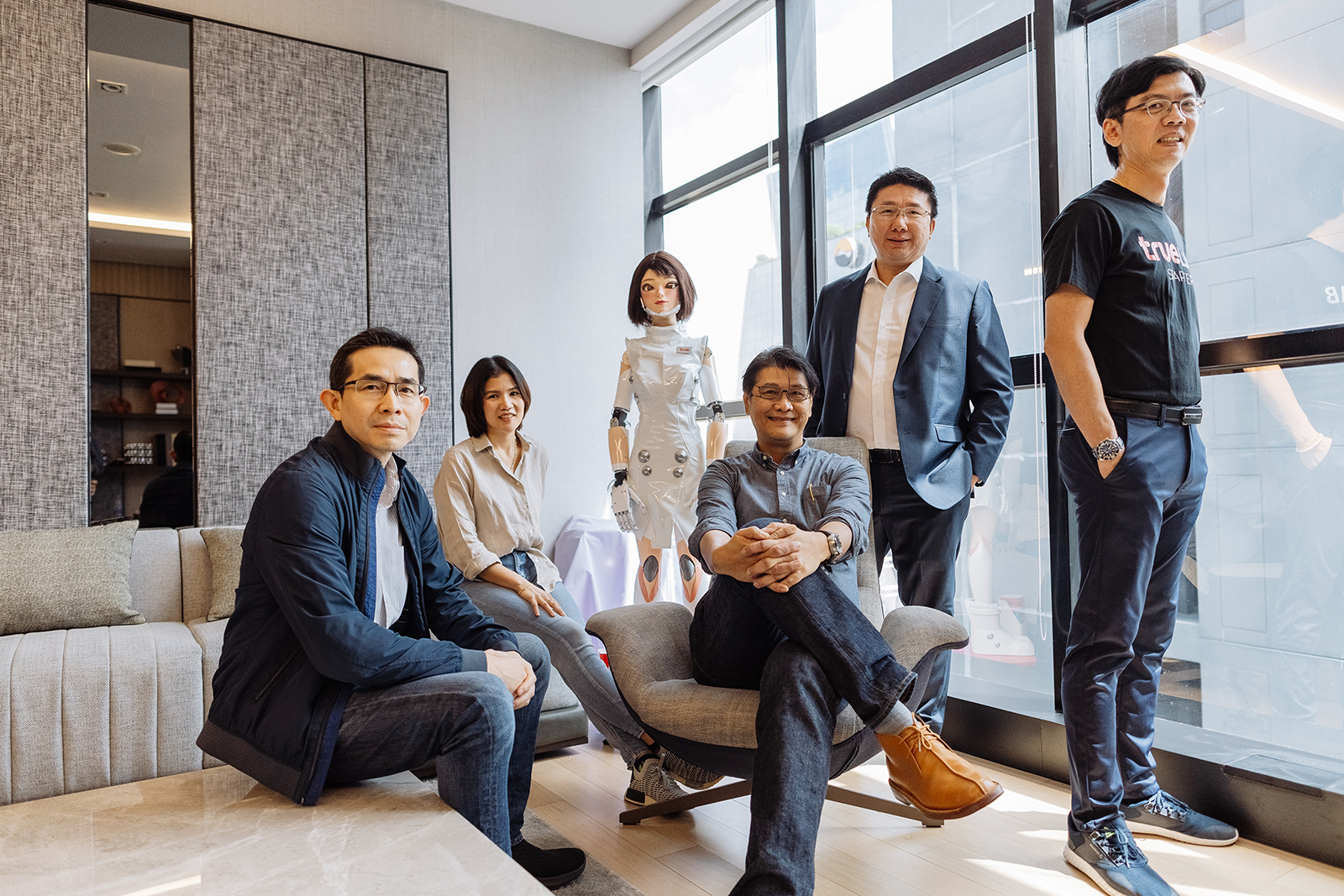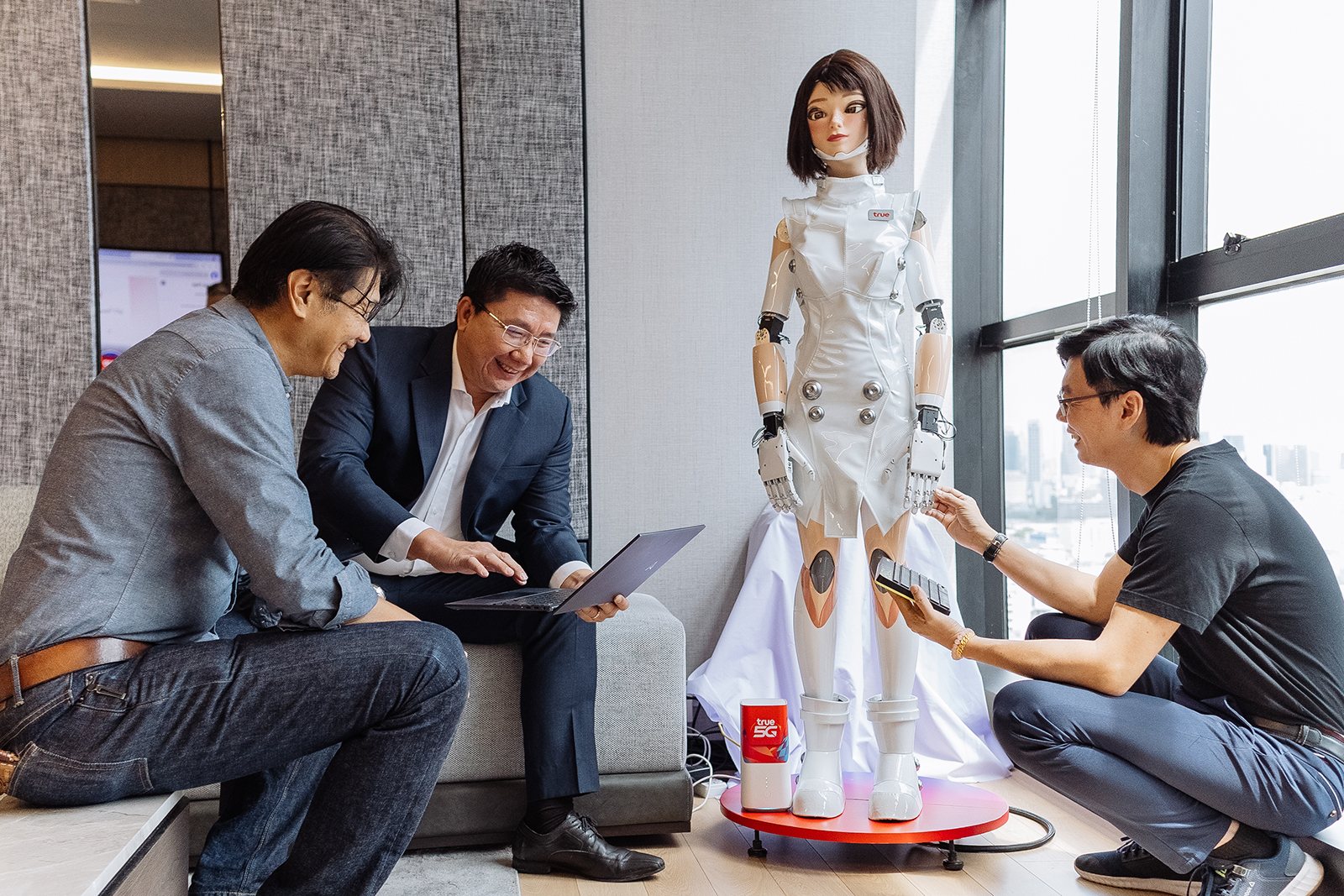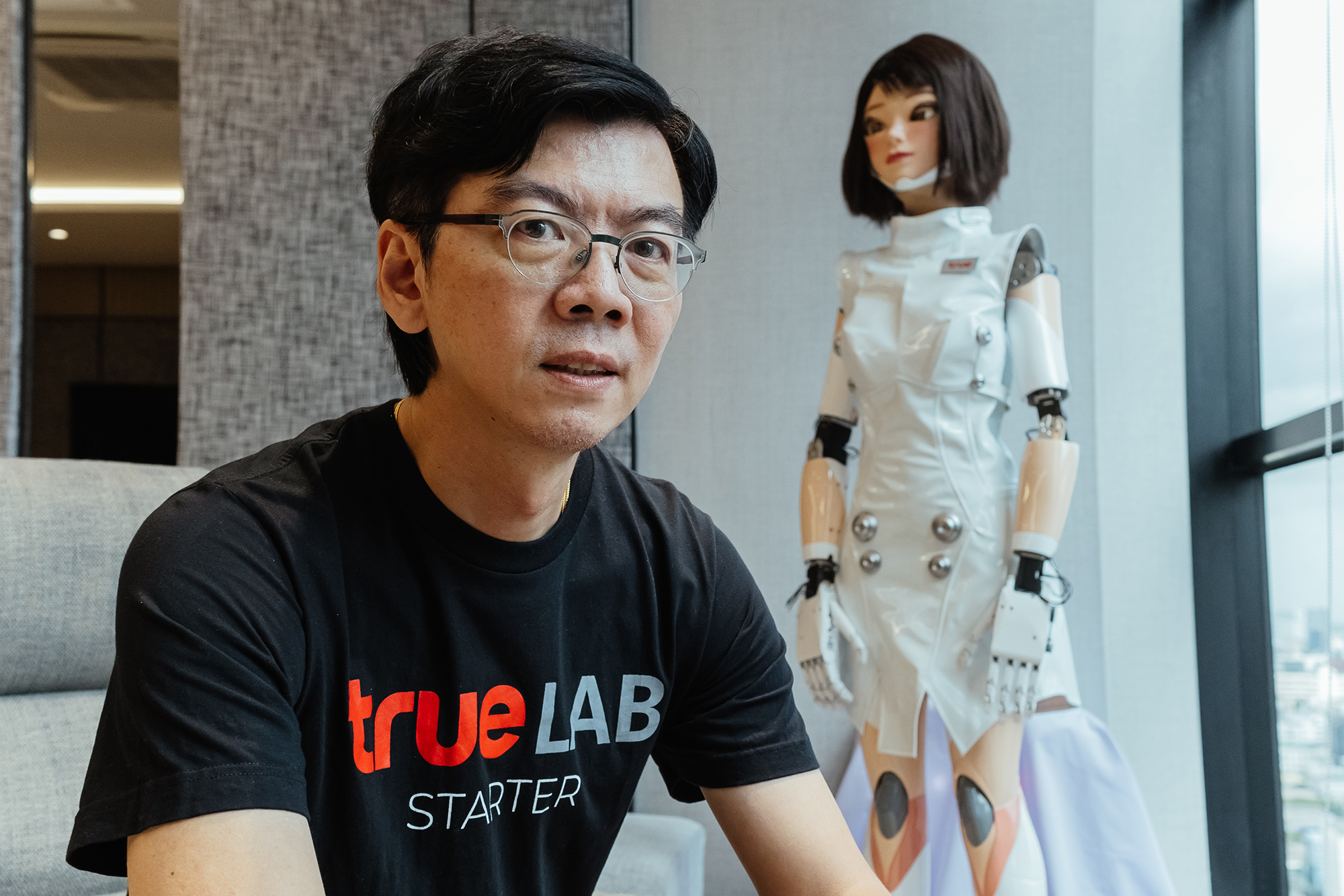
- เมื่อเร็วๆ นี้ ทรู คอร์ปอเรชั่น ได้เปิดตัว มะลิ 0 เจ้าหน้าที่บริการลูกค้าเสมือน ให้บริการทั้งทางแชท โทรศัพท์ หรือกระทั่งหุ่นยนต์ที่มีรูปลักษณ์เหมือนมนุษย์
- มะลิ 0 ได้รับการอัพเกรดโดยเทคโนโลยี Gen AI ทำให้การให้บริการผ่านบทสนทนาที่มีความเป็นธรรมชาติยิ่งขึ้น
- มะลิมีวิวัฒนาการอย่างรวดเร็ว สามารถให้บริการลูกค้าจำนวนมาก พร้อมแก้ไขนานาปัญหา
18 กรกฎาคม 2567 – “สวัสดีค่ะ มะลิยินดีให้บริการ วันนี้ให้มะลิดูแลเรื่องอะไรดีคะ?” และนี่คือคำกล่าวทักทายกับลูกค้า เวอร์ชั่นล่าสุดที่แสดงให้เห็นถึงความสามารถในการสนทนาที่เป็นธรรมชาติ จากนั้นคู่สนทนาจึงอธิบายถึงความต้องการในการเปลี่ยนแพ็คเกจโทรศัพท์ โดยมะลิเข้าใจความต้องการเป็นอย่างดี ทำให้ลูกค้าสามารถเปลี่ยนไปใช้แพ็คเกจใหม่ได้อย่างรวดเร็ว

การสนทนาอย่างเป็นกันเองกับ Mari ในบทบาท Virtual Agent (เจ้าหน้าที่เสมือน) แสดงให้เห็นถึงการปฏิวัติแห่งการบริการลูกค้า แม้ว่าการให้บริการลูกค้าอัตโนมัติในรูปแบบดิจิทัลจะมีมานานหลายสิบปีแล้ว แต่ปัญหาที่พบเจอได้บ่อย นั่นคือ ระบบอินเตอร์เฟซที่ตอบสนองอย่างอืดอาด แถบเมนูที่ยาวเป็นโยชน์ รวมถึงตัวเลือกบริการที่ไม่ตอบโจทย์ความต้องการลูกค้า แต่ด้วยศักยภาพของ Generative AI ช่วยเอื้อต่อวิธีการต่างๆ ที่ทำให้บทสนทนามีความเป็นธรรมชาติ
ที่ ทรู คอร์ปอเรชั่น “มะลิ” ได้ทำหน้าที่ช่วยเหลือ แก้ไขปัญหาให้ลูกค้าอยู่แล้วในทุกๆ วัน แต่ด้วยบริบทในการให้บริการของผู้ให้บริการมือถืออย่างทรู ข้อมูลที่ในการให้บริการลูกค้านั้นจำต้องอาศัยความถูกต้องสูงสุด โดยเจ้าหน้าที่เสมือนก็จะต้องปฏิบัติตนให้สอดรับกับบุคลิกของแบรนด์ ปรับโทนเสียงตามคู่สนทนา และรู้ว่าเมื่อใดที่ควรส่งต่อเคสให้เจ้าหน้าที่ที่เป็นมนุษย์รับมือต่อ True Blog ได้พูดคุยกับทีมงานผู้อยู่เบื้องหลังการพัฒนา “มะลิ” ถึงการสร้างสมดุลระหว่างการทดลองใช้เทคโนโลยีใหม่ๆ กับความแม่นยำในการให้บริการ

อีโคซิสเต็มของ “มะลิ”
มะลิกำลังกลายเป็นสิ่งที่ลูกค้าทรูกว่า 50 ล้านรายคุ้นเคย ทั้งจากการมีปฏิสัมพันธ์ต่อหน้าและผ่านเสียง เธอจะคอยทักทายผู้เข้าชมเว็บไซต์ทรู ผ่านสายโทรศัพท์หมายเลข 1242 หรือแม้กระทั่ง พบเจอตัวเป็นๆ ในรูปแบบของหุ่นยนต์ที่มีรูปร่างเหมือนมนุษย์ (Humanoid Robot) มะลิในรูปแบบที่แตกต่างกันเกิดจากการประกอบสร้างด้วยอีโคซิสเต็มที่มีความซับซ้อนจากเครื่องกล AI ชุดที่แตกต่างกัน เพื่อให้สอดรับกับความต้องการของมะลิในแต่ละรูปแบบ
“มะลิได้รับการออกแบบให้เหมาะสมกับช่องทางที่แตกต่างกัน เพียงแค่ลูกค้าติดต่อฝ่ายบริการลูกค้า ลองจินตนาการดูว่า หากคุณสอบถามราคาแพ็คเกจหรือเครื่องโทรศัพท์มือถือผ่านช่องทางแชท มะลิจะแสดงผลการเปรียบเทียบราคาในรูปแบบตาราง เช่นเดียวกับที่พนักงานขายทำในร้านด้วยแผ่นพับโบรชัวร์ แต่ถ้าหากเป็นการโทรเข้าไป คุณอาจต้องรอให้พนักงานคอลเซ็นเตอร์อ่านข้อมูลสเปคของแต่ละรุ่นราว 30 วินาที ซึ่งนี่คือความแตกต่างของมะลิในรูปแบบแชทและเสียง” เกียรติศักดิ์ ศรีมาดี หัวหน้าแผนก True Voice กล่าว
ทั้งนี้ True Voice คือแผนกที่ทำหน้าที่พัฒนา NLP หรือ Natural Language Processing ซึ่งเป็นเทคโนโลยีประมวลผลภาษาธรรมชาติ เพื่อการประยุกต์ใช้ในงานคอลเซ็นเตอร์ ขณะที่ทีมคอลเซ็นเตอร์ทำหน้าที่รับผิดชอบการฝึก ตลอดจนปรับปรุงการถามตอบของมะลิ

คุณธนาชัย ชูกลิ่น หัวหน้าฝ่าย Strategy, Resourcing & Transformation สายงานคอลเซ็นเตอร์ อธิบายว่า “โทนเสียงและการออกเสียงถือเป็นจุดที่สำคัญอย่างมากในงานคอลเซ็นเตอร์ ซึ่งเราค่อนข้างพึงพอใจกับสิ่งที่เราทำได้ในตอนนี้ และเราจะยังคงพัฒนาต่อไปเรื่อยๆ โดยจำเป็นต้องทดลองทดสองนับครั้งไม่ถ้วน เพื่อให้สื่อความหมายได้ถูกต้อง ทั้งจุดประสงค์ สไตล์ และอารมณ์”
ส่วนมะลิในรูปแบบ chatbot นั้น ต่างก็มีความท้าทายที่เฉพาะตัว โดยเฉพาะการให้ความสำคัญกับความต้องการต่างๆ เพื่อความถูกต้องของข้อมูล และการใช้คำให้เหมาะสม อย่างไรก็ตาม มะลิทั้งรูปแบบเสียงและแชทต่างมีสิ่งที่เหมือนกัน นั่นคือ คนที่ใช่ เพื่อรับบริการจากมะลิ เพราะไม่ใช่ว่าทุกคนพร้อมที่จะสื่อสารกับ Gen AI
“ในช่วงการแพร่ระบาดของโรคโควิด เราเห็นผู้คนจำนวนมากแห่ใช้บริการช่องทางดิจิทัล และอัตราความพึงพอใจและความคุ้นเคยก็เพิ่มสูงขึ้นเรื่อยๆ ต่างจากจำนวนผู้รับบริการทางหน้าร้านที่มีจำนวนลดลง แต่นั่นก็ไม่ได้หมายความว่าพวกเขาพร้อมที่จะใช้บริการจาก Gen AI อย่างเต็มตัว เรายังจำเป็นต้องประเมินการใช้บริการกับมะลิของลูกค้าอย่างค่อยเป็นค่อยไป หากสิ่งที่ลูกค้าต้องการเป็นอะไรที่พื้นฐานมากๆ การเลือกค้นหาจากเมนู ยังอาจเป็นวิธีการที่ดีที่สุด แต่หากเป็นเรื่องที่ซับซ้อนมากๆ มะลิน่าจะเป็นคำตอบที่ดีกว่า” ณพงศ์ วลัยเสถียร หัวหน้าฝ่ายดิจิทัลแพลทฟอร์มและประสบการณ์ดิจิทัล ผู้รับผิดชอบหลักมะลิ chatbot ระบุ
พัฒนาการที่รวดเร็วของมะลิ
เมื่อพูดถึงงานบริการ ช่องว่างสัดส่วนระหว่างผู้ที่ต้องการสื่อสารกับมนุษย์และเจ้าหน้าที่เสมือนที่พัฒนาจาก AI ลดลงอย่างรวดเร็ว ผลการสำรวจจากงานสัมมนา AI Gets Real ระบุว่า เมื่อต้องติดต่อผ่านแชท 26% ของผู้ตอบแบบสอบถามเลือกที่จะแชทออนไลน์กับเจ้าหน้าที่เสมือน ขณะที่ 20% เลือกที่จะแชทกับกับเจ้าหน้าที่ที่เป็นมนุษย์มากกว่า แต่หากเป็นบริการรูปแบบเสียง 38% เลือกที่จะพูดคุยกับมนุษย์ และเพียง 16% ที่เลือกสื่อสารกับหุ่นยนต์

คุณธัญญลักษมณ์ สุทธิจินดาวงศ์ หัวหน้าอาวุโส แผนกแพลทฟอร์มดิจิทัล กล่าวว่า “เรายังคงเดินหน้าขยายศักยภาพมะลิในรูปแบบ chatbot อย่างต่อเนื่อง โดยเราเริ่มต้นจากความต้องการลูกค้า จากนั้นจึงระดมความคิดเห็นผ่านมุมมองลูกค้า ในการทำงานนั้น ถือว่าเป็นไปอย่างรวดเร็ว สามารถปล่อยฟีเจอร์ใหม่ๆ ในระยะเวลาเพียง 2 สัปดาห์ ผ่านความร่วมมือกับทีมต่างๆ ไม่ว่าจะเป็นวิเคราะห์ระบบ วิเคราะห์ธุรกิจ พัฒนา และควบคุมคุณภาพ
ปัจจุบัน มะลิ chatbot ทำหน้าที่รับมือ แก้ไขปัญหาให้ลูกค้ากว่า 2 ล้านครั้งต่อเดือน ซึ่ง 90% ของจำนวนดังกล่าว มะลิสามารถจัดการปัญหาให้ลูกค้าได้ทั้งหมด มีเพียง 10% เท่านั้นที่ถูกส่งต่อไปยังเจ้าหน้าที่ที่เป็นมนุษย์รับเรื่องต่อ ซึ่งจากการให้บริการที่ผ่านมา ความพึงพอใจของลูกค้าที่มีต่อมะลิมีคะแนนสูงกว่ามาตรฐานโลกแล้วด้วย
มะลิยังคงถูกพัฒนาอย่างไม่หยุดยั้ง มะลิ chatbot สามารถช่วยลูกค้าแก้ไขปัญหาทางเทคนิคจากบริการเน็ตบ้านได้แล้ว รวมถึงเปรียบเทียบสเปคอุปกรณ์ และช่วยลูกค้าเปลี่ยนแพ็คเกจ ในส่วนของมะลิ voicebot นั้น มีการใช้โมเดล AI ที่แตกต่างกัน รวมถึงความซับซ้อนในการสื่อสาร/ส่งผ่านข้อมูลทางเสียง ทำให้กำหนดเวลาของการพัฒนาฟีเจอร์แตกต่างกับ chatbot เล็กน้อย ทั้งนี้ทั้งนั้น มะลิ ทั้ง chatbot และ voicebot ทำหน้าที่ให้บริการแก่ลูกค้าเป็นที่เรียบร้อยแล้ว
เกียรติศักดิ์ บอกว่า “Gen AI ถือเป็นความท้าทายอย่างแท้จริง หากพิจารณาจากมุมจริยธรรม เราจำเป็นต้องมั่นใจว่า เราได้ให้บริการและดูแลทุกคนอย่างเป็นกลางและถูกต้อง ความผิดพลาดของ AI หรือที่รู้จักกันว่า “อาการหลอน” (Hallucinations) เป็นสิ่งที่ยอมรับไม่ได้ เราจะไม่ยอมเห็นมะลิเสนอแพ็คเกจที่ไม่มีอยู่จริง เราจึงจำเป็นต้องระมัดระวังอย่างยิ่ง และนี่แหละ คือส่วนที่ยากของ AI”

คุณวีรศักดิ์ พงษ์ธัญญวิชัย หัวหน้าฝ่าย True Innovation Center ผู้พัฒนามะลิรูปแบบหุ่นยนต์ Humanoid ที่สามารถสื่อสารได้อย่างเป็นธรรมชาติ บอกว่า “ปัจจุบัน เราวางมะลิ humanoid robot เป็นเพียงกรณีตัวอย่างที่สะท้อนถึงความเป็นไปได้แห่งการพัฒนา ทำหน้าที่เป็นทูตนวัตกรรมของทรู แต่ในอนาคต มะลิ humanoid robot อาจทำหน้าที่เป็นผู้ช่วยให้พนักงานขายที่ศูนย์บริการ เช่นเดียวกับมะลิ chatbot และ voicebot เพราะเป้าหมายของมะลิคือต้องการช่วยเหลือทุกๆ คน”
How True’s Mari is Revolutionizing Customer Care with Gen AI
- True Corporation has unveiled the third generation of Mari, a virtual service agent available via chat, over the phone, or even as a humanoid robot.
- Mari uses generative artificial intelligence to provide service using natural, conversation language.
- She is rapidly evolving to reach more customers and handle a wider range of uses.
July 18, 2024 – Bangkok, Thailand – “Hello! Mari is happy to serve all customers. How can I help you today?” This is how True Corporation’s generative artificial intelligence greeted a customer during a recent demo of her newfound ability to converse naturally. The customer then went on to explain he’d like to change mobile packages. After a chat with “Mari” to understand his options, he was quickly able to subscribe to a new plan.
This kind of casual chat with a virtual service agent represents a revolution in customer service. Although automated digital customer services have existed for decades, they were often plagued with clunky interfaces, lengthy menus, or options that didn’t meet users’ specific needs. With generative AI, all this is set to make way for natural conversations.
At True Corporation, Mari is already assisting customers every day. But for a mobile operator like True Corporation, customer service information requires a very high degree of accuracy. Virtual agents must also somehow capture the brand’s personality, adjust their tone based on the speaker, and know which cases to hand off to human agents. To find out how Mari balances experimental technology with a need for precision, True Blog met with the teams pulling “her” strings behind the scenes.
The Mari Ecosystem
Mari is becoming a familiar face—or voice—for True’s 50 million customers. She greets visitors on the company’s website, can be reached by calling 1242 and can even be met in the real-world, in the shape of a humanoid robot. This constitutes a complex ecosystem with different AI engines best suited for each need.
“Mari is uniquely tailored to the different channels by which customers can reach customer service. Imagine you’re asking to compare price plans or devices, for example. Via chat, Mari could show you a table to compare a few different options—just like what a salesperson would do in a shop by showing you a pamphlet. But if a call center agent read out specs for five devices on a call, you’d hang up on them after 30 seconds. That’s Mari voice and Mari chat are not the same,” said Kiattisak Srimadee, Head of True Voice Department.
The True Voice team built the natural language processing engine of the call center’s Mari. But training and fine-tuning her responses was done by the call center itself. Thanachai Chuklin, who is head of the call center’s Strategy, Resourcing & Transformation Department said, “Getting the right tone and voice is very important in call centers. We’re quite happy with what we’ve achieved now but we’re still looking to improve. It takes a lot of testing to get the right intent, style and mood,” he said.
Compared to Mari voice, the chatbot version of True’s virtual service agent doesn’t require a voice engine. But it too must contend with exacting requirements for accuracy and tone. And both platforms also share the need to find the right customers—as not everyone is ready for generative AI.
“With COVID, we saw more and more people pushed to digital channels and they’ve grown increasingly comfortable with and accustomed to getting service online as opposed to visiting a shop or speaking to a human call center agent. But that doesn’t mean they are ready for Generative AI. We have to carefully assess their intent when they reach out to Mari. Very simple requests are best handled by click-through menus. If their needs are more complex, we can point them towards a generative AI,” said Napong Valaisathien, Head of the Digital Platform & Experience Department, the team driving Mari’s chat platform.
Growing Powers
When it comes to service, the gap between those who’d rather talk to humans versus those who prefer AI-powered virtual agents is closing fast. In a survey conducted during “AI Gets Real,” an event where True presented real-world AI use cases, 26% of respondents already say they prefer to chat online with a virtual agent versus 20% who would prefer to chat with a human agent. But when it comes to voice, 38% said they’d prefer to talk to a human agent, while 16% would prefer to speak with a virtual agent.
Thanyalak Suthijindawong, Senior Leader, Digital Platform, said, “We are constantly improving Mari’s chat capabilities. We start from the customer and then we brainstorm what we can improve from their perspective. We work very quickly, in two-week sprints, to bring out new features in collaboration with system analysts, developers, business analysts and quality control.”
Currently, the Mari chatbot already handles nearly 2 million contacts per month, with Mari handling nearly 90% of them and human agents handling the rest. Thaks to an accuracy of about 90-95%, Mari is able to beat global benchmarks for customer satisfaction.
Currently, the chatbot can resolve technical faults for home internet users, compare devices and assist customers wishing to change plans. Because the voice version of Mari uses a different engine, and the inherent difficulty of conveying complex information over the phone, the timeline of features is slightly different for the call center. But both versions of Mari are now live and used by real customers.
Mr. Kiattisak said, “Gen AI is a real challenge. From an ethical standpoint, we need to make sure everyone gets treated fairly. AI mistakes, or what’s known as ‘hallucinations,’ aren’t acceptable. We can’t have Mari offering price plans that don’t exist, or priced incorrectly. We need to be very cautious. That’s the hard part with AI. We need to be very accurate.”
In the future, it’s possible to even imagine Mari in shops. Veerasak Pongtanyavichai, Head of Innovation Center Department, has developed a humanoid robot version of Mari capable of conversing naturally. “For now, we plan for the Mari humanoid to be mainly a showcase of what’s possible. She can act as an ambassador for True at major events. But in the future, she could act as an assistant for salespeople in shops. Just like the chat and voice versions of Mari, her goal is to be helpful for everyone,” said Mr. Veerasak.
ที่มา ทรู คอร์ปอเรชั่น

